Business Decision Planning: Market Analysis of Salus Supermarket LTD
VerifiedAdded on 2023/06/15
|24
|6333
|165
Report
AI Summary
This report presents a comprehensive analysis of Salus Supermarket, focusing on market dynamics, customer behavior, and business decision-making processes. Primary data is collected through questionnaires distributed to customers, while secondary data is gathered from published articles and competitor analysis. The research covers key areas such as customer buying patterns, promotional activities, customer satisfaction levels, and challenges faced by the supermarket. Statistical data analysis, including mean, median, and mode, is employed to interpret customer satisfaction levels. The findings and recommendations aim to provide Salus Supermarket with insights to enhance its competitive advantage and strategic planning. The report concludes with a summary of the research outcomes and suggestions for future improvements.
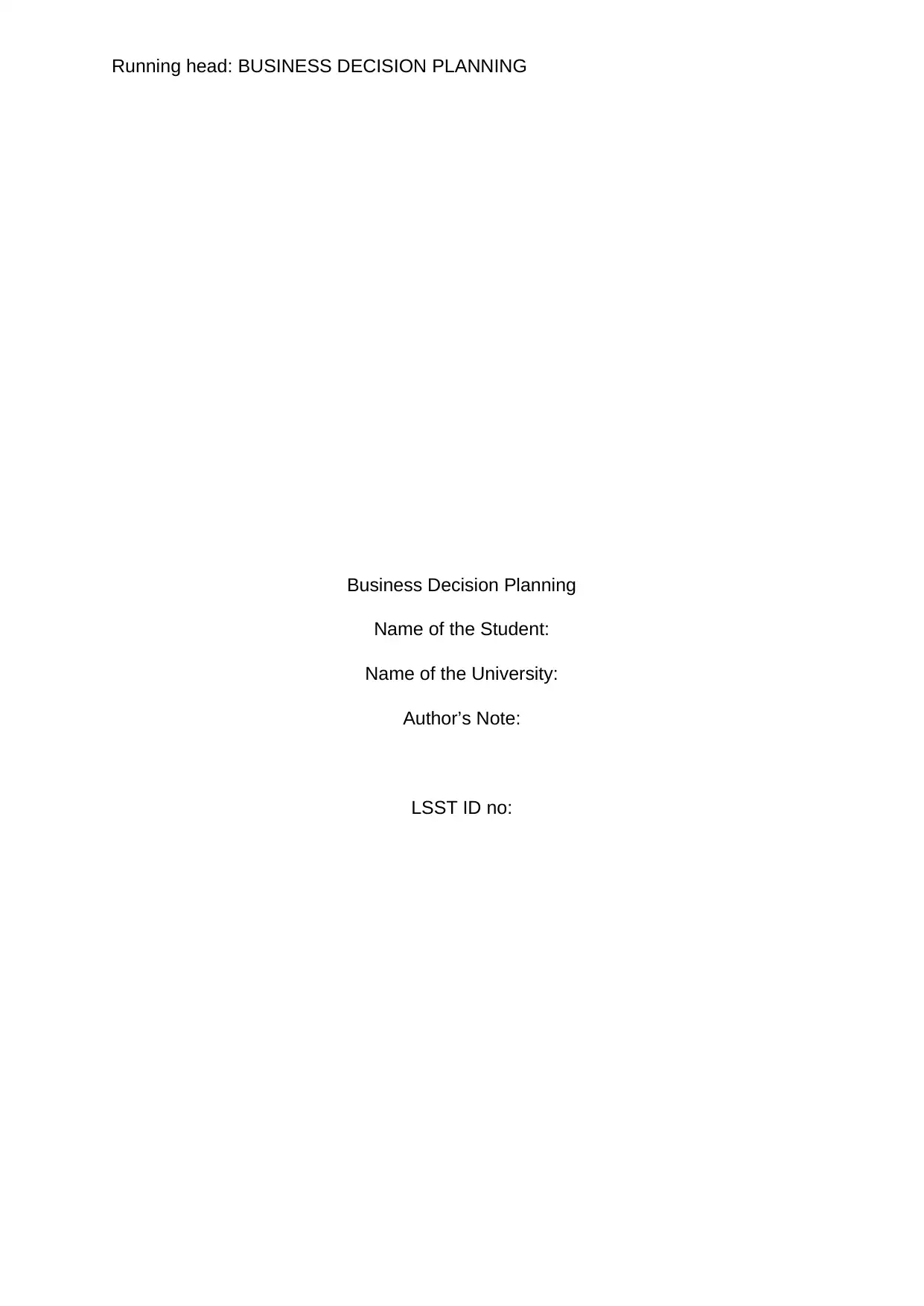
Running head: BUSINESS DECISION PLANNING
Business Decision Planning
Name of the Student:
Name of the University:
Author’s Note:
LSST ID no:
Business Decision Planning
Name of the Student:
Name of the University:
Author’s Note:
LSST ID no:
Paraphrase This Document
Need a fresh take? Get an instant paraphrase of this document with our AI Paraphraser
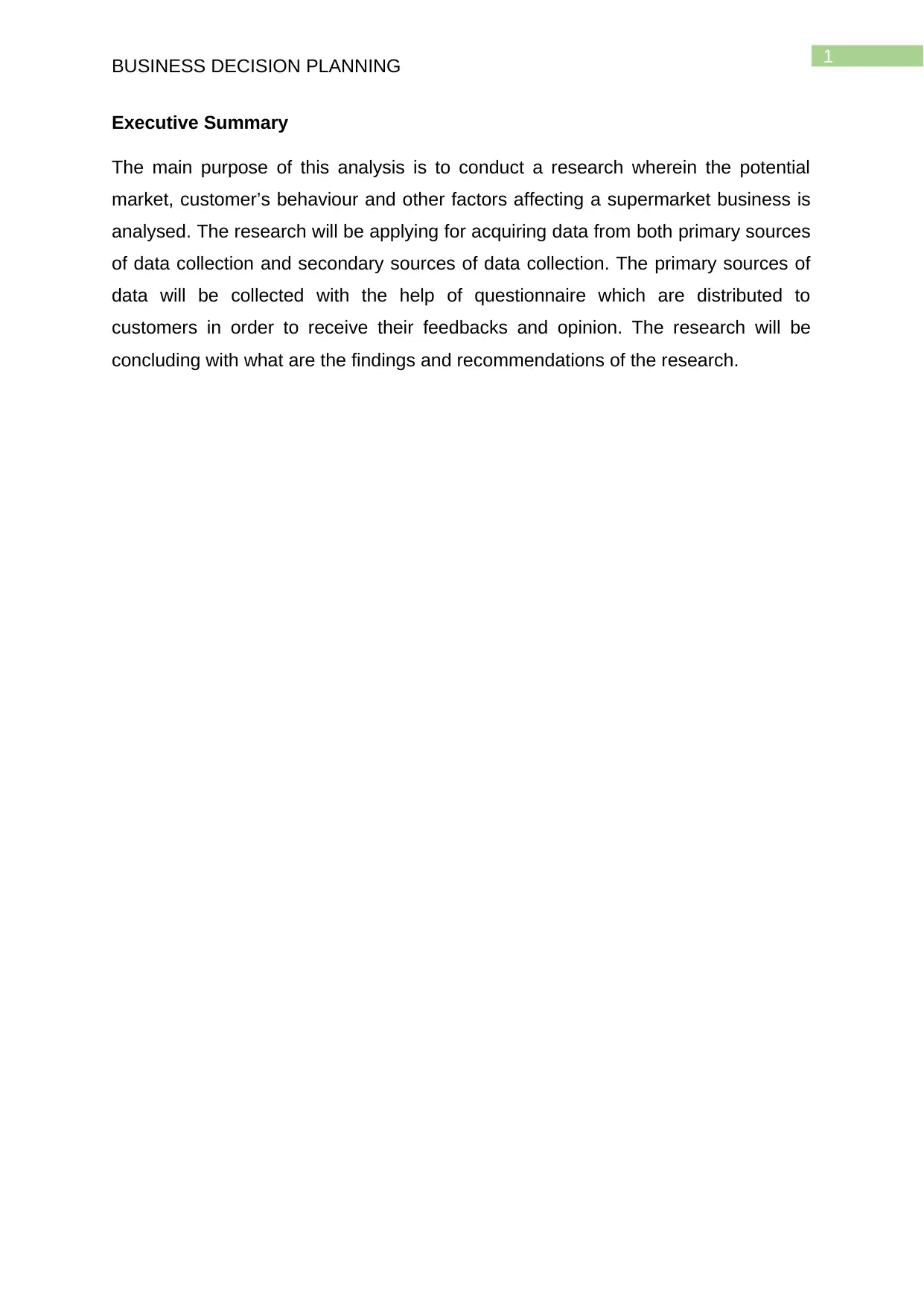
1
BUSINESS DECISION PLANNING
Executive Summary
The main purpose of this analysis is to conduct a research wherein the potential
market, customer’s behaviour and other factors affecting a supermarket business is
analysed. The research will be applying for acquiring data from both primary sources
of data collection and secondary sources of data collection. The primary sources of
data will be collected with the help of questionnaire which are distributed to
customers in order to receive their feedbacks and opinion. The research will be
concluding with what are the findings and recommendations of the research.
BUSINESS DECISION PLANNING
Executive Summary
The main purpose of this analysis is to conduct a research wherein the potential
market, customer’s behaviour and other factors affecting a supermarket business is
analysed. The research will be applying for acquiring data from both primary sources
of data collection and secondary sources of data collection. The primary sources of
data will be collected with the help of questionnaire which are distributed to
customers in order to receive their feedbacks and opinion. The research will be
concluding with what are the findings and recommendations of the research.
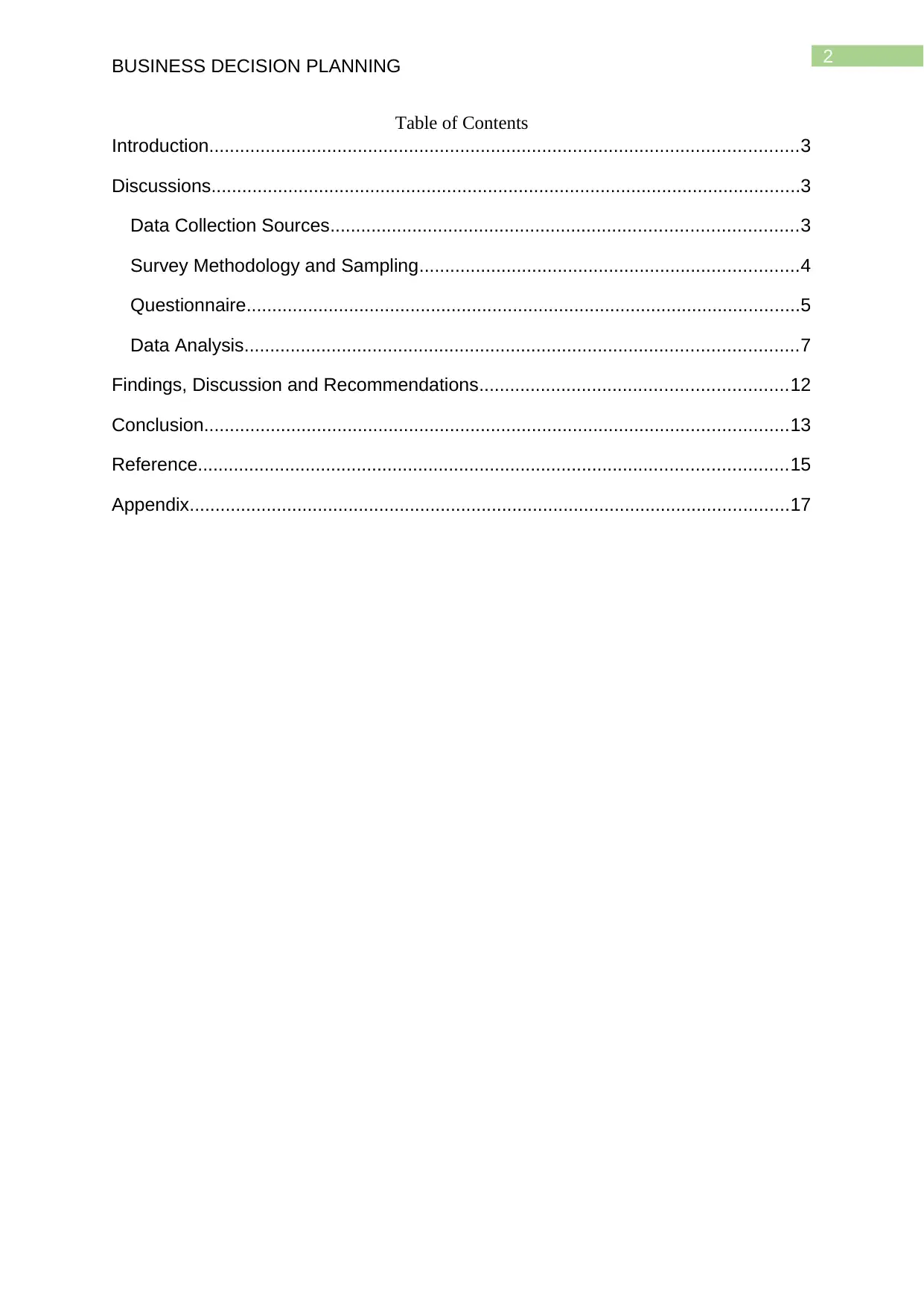
2
BUSINESS DECISION PLANNING
Table of Contents
Introduction...................................................................................................................3
Discussions...................................................................................................................3
Data Collection Sources...........................................................................................3
Survey Methodology and Sampling..........................................................................4
Questionnaire............................................................................................................5
Data Analysis............................................................................................................7
Findings, Discussion and Recommendations............................................................12
Conclusion..................................................................................................................13
Reference...................................................................................................................15
Appendix.....................................................................................................................17
BUSINESS DECISION PLANNING
Table of Contents
Introduction...................................................................................................................3
Discussions...................................................................................................................3
Data Collection Sources...........................................................................................3
Survey Methodology and Sampling..........................................................................4
Questionnaire............................................................................................................5
Data Analysis............................................................................................................7
Findings, Discussion and Recommendations............................................................12
Conclusion..................................................................................................................13
Reference...................................................................................................................15
Appendix.....................................................................................................................17
⊘ This is a preview!⊘
Do you want full access?
Subscribe today to unlock all pages.

Trusted by 1+ million students worldwide
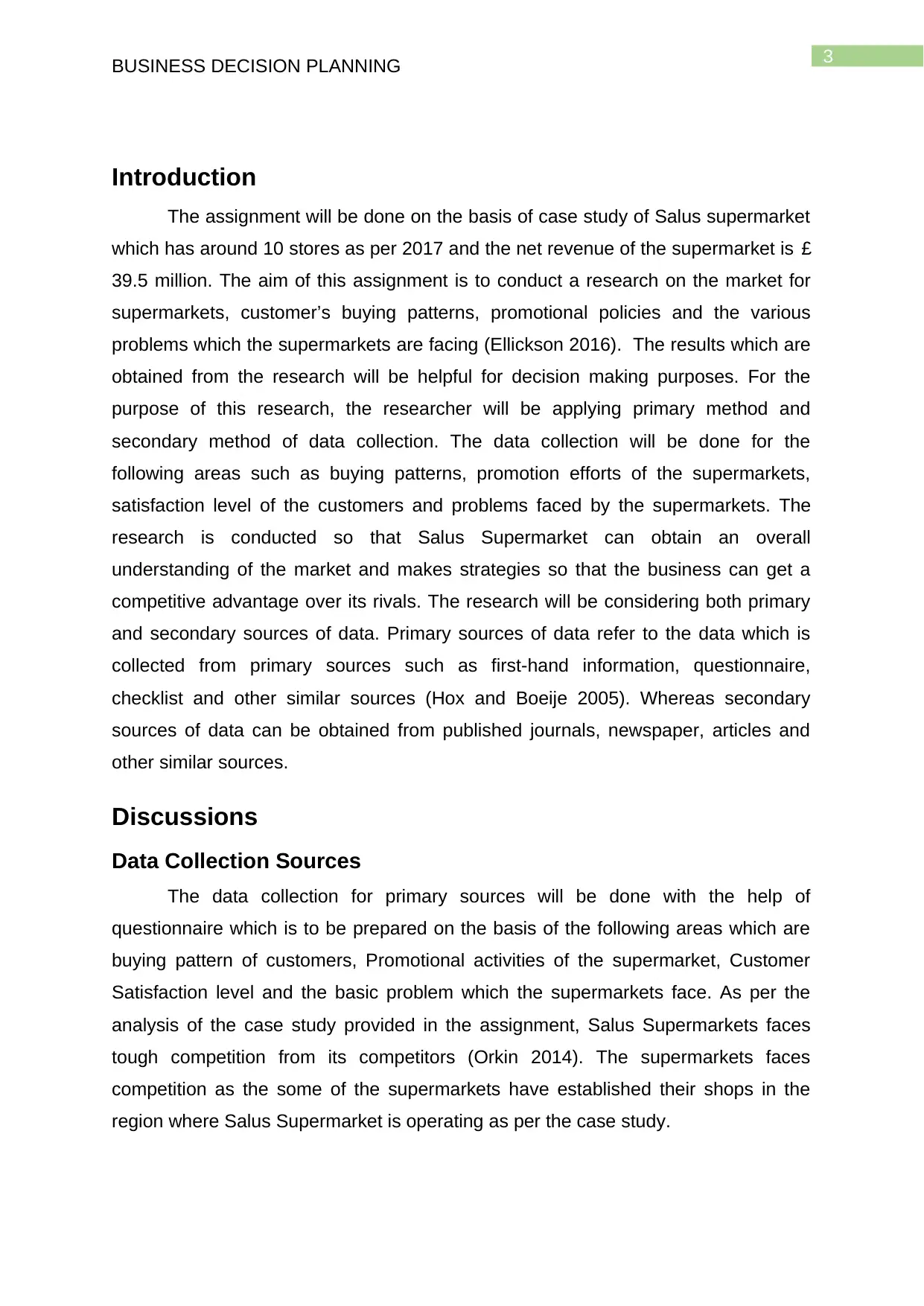
3
BUSINESS DECISION PLANNING
Introduction
The assignment will be done on the basis of case study of Salus supermarket
which has around 10 stores as per 2017 and the net revenue of the supermarket is £
39.5 million. The aim of this assignment is to conduct a research on the market for
supermarkets, customer’s buying patterns, promotional policies and the various
problems which the supermarkets are facing (Ellickson 2016). The results which are
obtained from the research will be helpful for decision making purposes. For the
purpose of this research, the researcher will be applying primary method and
secondary method of data collection. The data collection will be done for the
following areas such as buying patterns, promotion efforts of the supermarkets,
satisfaction level of the customers and problems faced by the supermarkets. The
research is conducted so that Salus Supermarket can obtain an overall
understanding of the market and makes strategies so that the business can get a
competitive advantage over its rivals. The research will be considering both primary
and secondary sources of data. Primary sources of data refer to the data which is
collected from primary sources such as first-hand information, questionnaire,
checklist and other similar sources (Hox and Boeije 2005). Whereas secondary
sources of data can be obtained from published journals, newspaper, articles and
other similar sources.
Discussions
Data Collection Sources
The data collection for primary sources will be done with the help of
questionnaire which is to be prepared on the basis of the following areas which are
buying pattern of customers, Promotional activities of the supermarket, Customer
Satisfaction level and the basic problem which the supermarkets face. As per the
analysis of the case study provided in the assignment, Salus Supermarkets faces
tough competition from its competitors (Orkin 2014). The supermarkets faces
competition as the some of the supermarkets have established their shops in the
region where Salus Supermarket is operating as per the case study.
BUSINESS DECISION PLANNING
Introduction
The assignment will be done on the basis of case study of Salus supermarket
which has around 10 stores as per 2017 and the net revenue of the supermarket is £
39.5 million. The aim of this assignment is to conduct a research on the market for
supermarkets, customer’s buying patterns, promotional policies and the various
problems which the supermarkets are facing (Ellickson 2016). The results which are
obtained from the research will be helpful for decision making purposes. For the
purpose of this research, the researcher will be applying primary method and
secondary method of data collection. The data collection will be done for the
following areas such as buying patterns, promotion efforts of the supermarkets,
satisfaction level of the customers and problems faced by the supermarkets. The
research is conducted so that Salus Supermarket can obtain an overall
understanding of the market and makes strategies so that the business can get a
competitive advantage over its rivals. The research will be considering both primary
and secondary sources of data. Primary sources of data refer to the data which is
collected from primary sources such as first-hand information, questionnaire,
checklist and other similar sources (Hox and Boeije 2005). Whereas secondary
sources of data can be obtained from published journals, newspaper, articles and
other similar sources.
Discussions
Data Collection Sources
The data collection for primary sources will be done with the help of
questionnaire which is to be prepared on the basis of the following areas which are
buying pattern of customers, Promotional activities of the supermarket, Customer
Satisfaction level and the basic problem which the supermarkets face. As per the
analysis of the case study provided in the assignment, Salus Supermarkets faces
tough competition from its competitors (Orkin 2014). The supermarkets faces
competition as the some of the supermarkets have established their shops in the
region where Salus Supermarket is operating as per the case study.
Paraphrase This Document
Need a fresh take? Get an instant paraphrase of this document with our AI Paraphraser
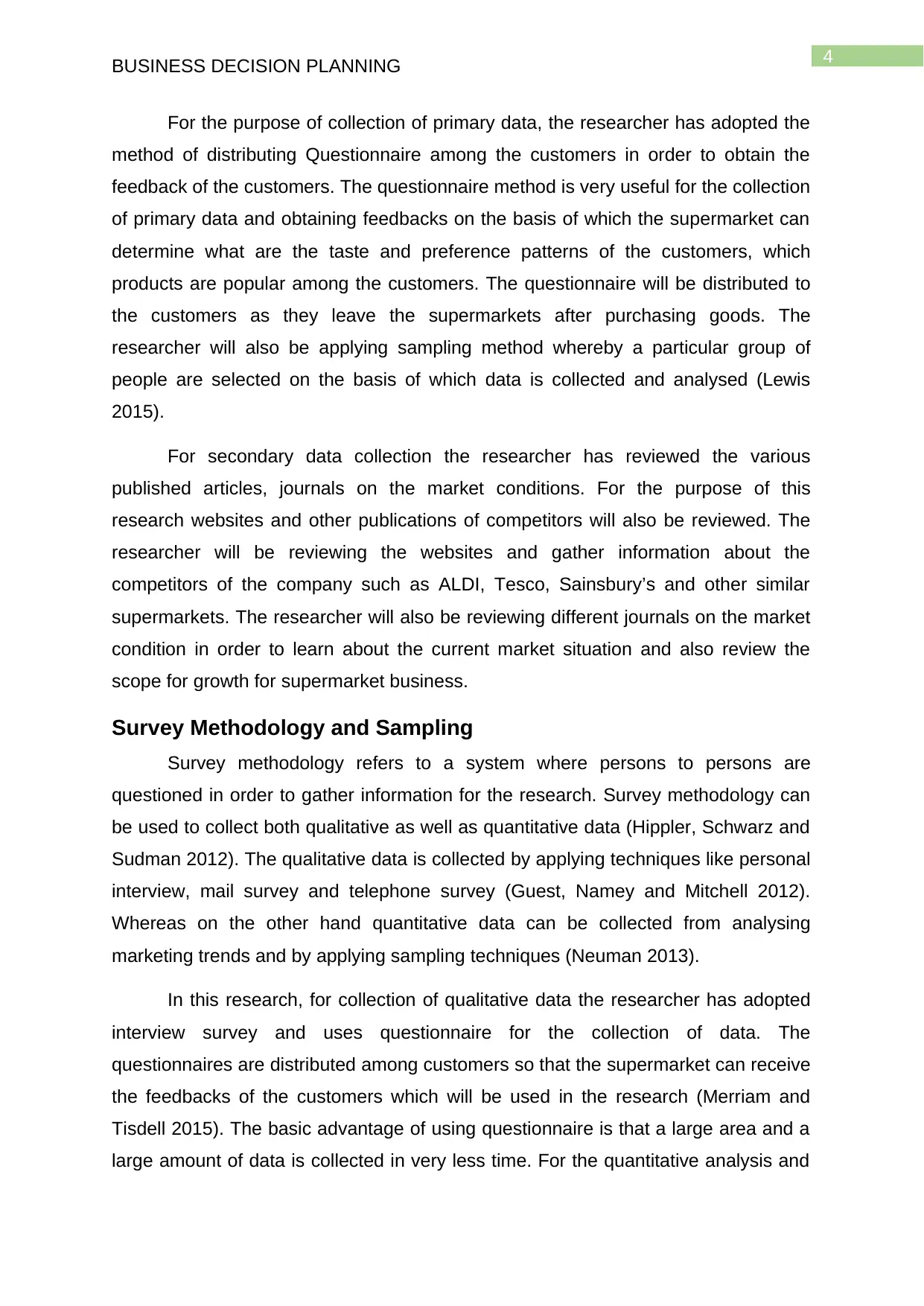
4
BUSINESS DECISION PLANNING
For the purpose of collection of primary data, the researcher has adopted the
method of distributing Questionnaire among the customers in order to obtain the
feedback of the customers. The questionnaire method is very useful for the collection
of primary data and obtaining feedbacks on the basis of which the supermarket can
determine what are the taste and preference patterns of the customers, which
products are popular among the customers. The questionnaire will be distributed to
the customers as they leave the supermarkets after purchasing goods. The
researcher will also be applying sampling method whereby a particular group of
people are selected on the basis of which data is collected and analysed (Lewis
2015).
For secondary data collection the researcher has reviewed the various
published articles, journals on the market conditions. For the purpose of this
research websites and other publications of competitors will also be reviewed. The
researcher will be reviewing the websites and gather information about the
competitors of the company such as ALDI, Tesco, Sainsbury’s and other similar
supermarkets. The researcher will also be reviewing different journals on the market
condition in order to learn about the current market situation and also review the
scope for growth for supermarket business.
Survey Methodology and Sampling
Survey methodology refers to a system where persons to persons are
questioned in order to gather information for the research. Survey methodology can
be used to collect both qualitative as well as quantitative data (Hippler, Schwarz and
Sudman 2012). The qualitative data is collected by applying techniques like personal
interview, mail survey and telephone survey (Guest, Namey and Mitchell 2012).
Whereas on the other hand quantitative data can be collected from analysing
marketing trends and by applying sampling techniques (Neuman 2013).
In this research, for collection of qualitative data the researcher has adopted
interview survey and uses questionnaire for the collection of data. The
questionnaires are distributed among customers so that the supermarket can receive
the feedbacks of the customers which will be used in the research (Merriam and
Tisdell 2015). The basic advantage of using questionnaire is that a large area and a
large amount of data is collected in very less time. For the quantitative analysis and
BUSINESS DECISION PLANNING
For the purpose of collection of primary data, the researcher has adopted the
method of distributing Questionnaire among the customers in order to obtain the
feedback of the customers. The questionnaire method is very useful for the collection
of primary data and obtaining feedbacks on the basis of which the supermarket can
determine what are the taste and preference patterns of the customers, which
products are popular among the customers. The questionnaire will be distributed to
the customers as they leave the supermarkets after purchasing goods. The
researcher will also be applying sampling method whereby a particular group of
people are selected on the basis of which data is collected and analysed (Lewis
2015).
For secondary data collection the researcher has reviewed the various
published articles, journals on the market conditions. For the purpose of this
research websites and other publications of competitors will also be reviewed. The
researcher will be reviewing the websites and gather information about the
competitors of the company such as ALDI, Tesco, Sainsbury’s and other similar
supermarkets. The researcher will also be reviewing different journals on the market
condition in order to learn about the current market situation and also review the
scope for growth for supermarket business.
Survey Methodology and Sampling
Survey methodology refers to a system where persons to persons are
questioned in order to gather information for the research. Survey methodology can
be used to collect both qualitative as well as quantitative data (Hippler, Schwarz and
Sudman 2012). The qualitative data is collected by applying techniques like personal
interview, mail survey and telephone survey (Guest, Namey and Mitchell 2012).
Whereas on the other hand quantitative data can be collected from analysing
marketing trends and by applying sampling techniques (Neuman 2013).
In this research, for collection of qualitative data the researcher has adopted
interview survey and uses questionnaire for the collection of data. The
questionnaires are distributed among customers so that the supermarket can receive
the feedbacks of the customers which will be used in the research (Merriam and
Tisdell 2015). The basic advantage of using questionnaire is that a large area and a
large amount of data is collected in very less time. For the quantitative analysis and
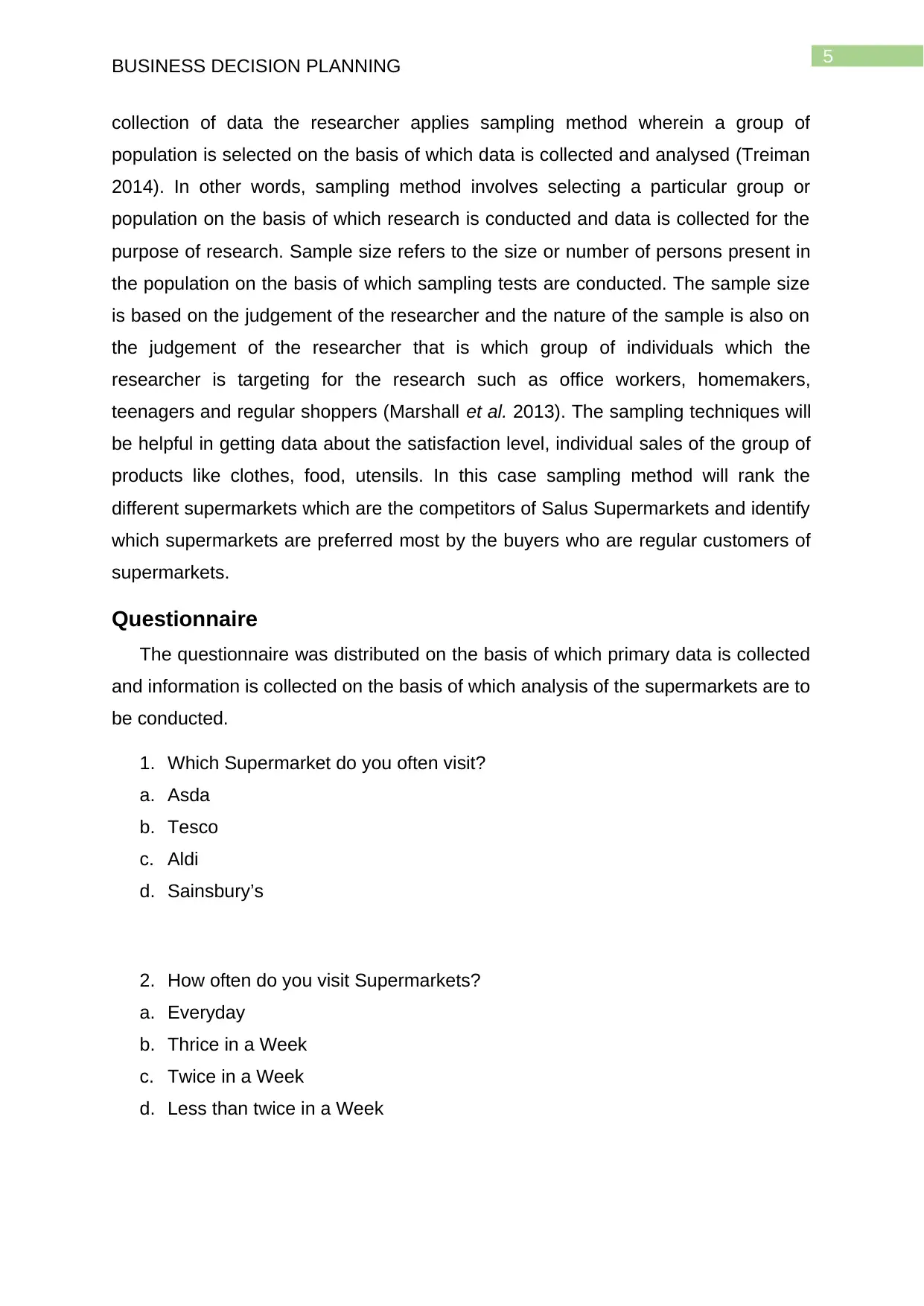
5
BUSINESS DECISION PLANNING
collection of data the researcher applies sampling method wherein a group of
population is selected on the basis of which data is collected and analysed (Treiman
2014). In other words, sampling method involves selecting a particular group or
population on the basis of which research is conducted and data is collected for the
purpose of research. Sample size refers to the size or number of persons present in
the population on the basis of which sampling tests are conducted. The sample size
is based on the judgement of the researcher and the nature of the sample is also on
the judgement of the researcher that is which group of individuals which the
researcher is targeting for the research such as office workers, homemakers,
teenagers and regular shoppers (Marshall et al. 2013). The sampling techniques will
be helpful in getting data about the satisfaction level, individual sales of the group of
products like clothes, food, utensils. In this case sampling method will rank the
different supermarkets which are the competitors of Salus Supermarkets and identify
which supermarkets are preferred most by the buyers who are regular customers of
supermarkets.
Questionnaire
The questionnaire was distributed on the basis of which primary data is collected
and information is collected on the basis of which analysis of the supermarkets are to
be conducted.
1. Which Supermarket do you often visit?
a. Asda
b. Tesco
c. Aldi
d. Sainsbury’s
2. How often do you visit Supermarkets?
a. Everyday
b. Thrice in a Week
c. Twice in a Week
d. Less than twice in a Week
BUSINESS DECISION PLANNING
collection of data the researcher applies sampling method wherein a group of
population is selected on the basis of which data is collected and analysed (Treiman
2014). In other words, sampling method involves selecting a particular group or
population on the basis of which research is conducted and data is collected for the
purpose of research. Sample size refers to the size or number of persons present in
the population on the basis of which sampling tests are conducted. The sample size
is based on the judgement of the researcher and the nature of the sample is also on
the judgement of the researcher that is which group of individuals which the
researcher is targeting for the research such as office workers, homemakers,
teenagers and regular shoppers (Marshall et al. 2013). The sampling techniques will
be helpful in getting data about the satisfaction level, individual sales of the group of
products like clothes, food, utensils. In this case sampling method will rank the
different supermarkets which are the competitors of Salus Supermarkets and identify
which supermarkets are preferred most by the buyers who are regular customers of
supermarkets.
Questionnaire
The questionnaire was distributed on the basis of which primary data is collected
and information is collected on the basis of which analysis of the supermarkets are to
be conducted.
1. Which Supermarket do you often visit?
a. Asda
b. Tesco
c. Aldi
d. Sainsbury’s
2. How often do you visit Supermarkets?
a. Everyday
b. Thrice in a Week
c. Twice in a Week
d. Less than twice in a Week
⊘ This is a preview!⊘
Do you want full access?
Subscribe today to unlock all pages.

Trusted by 1+ million students worldwide
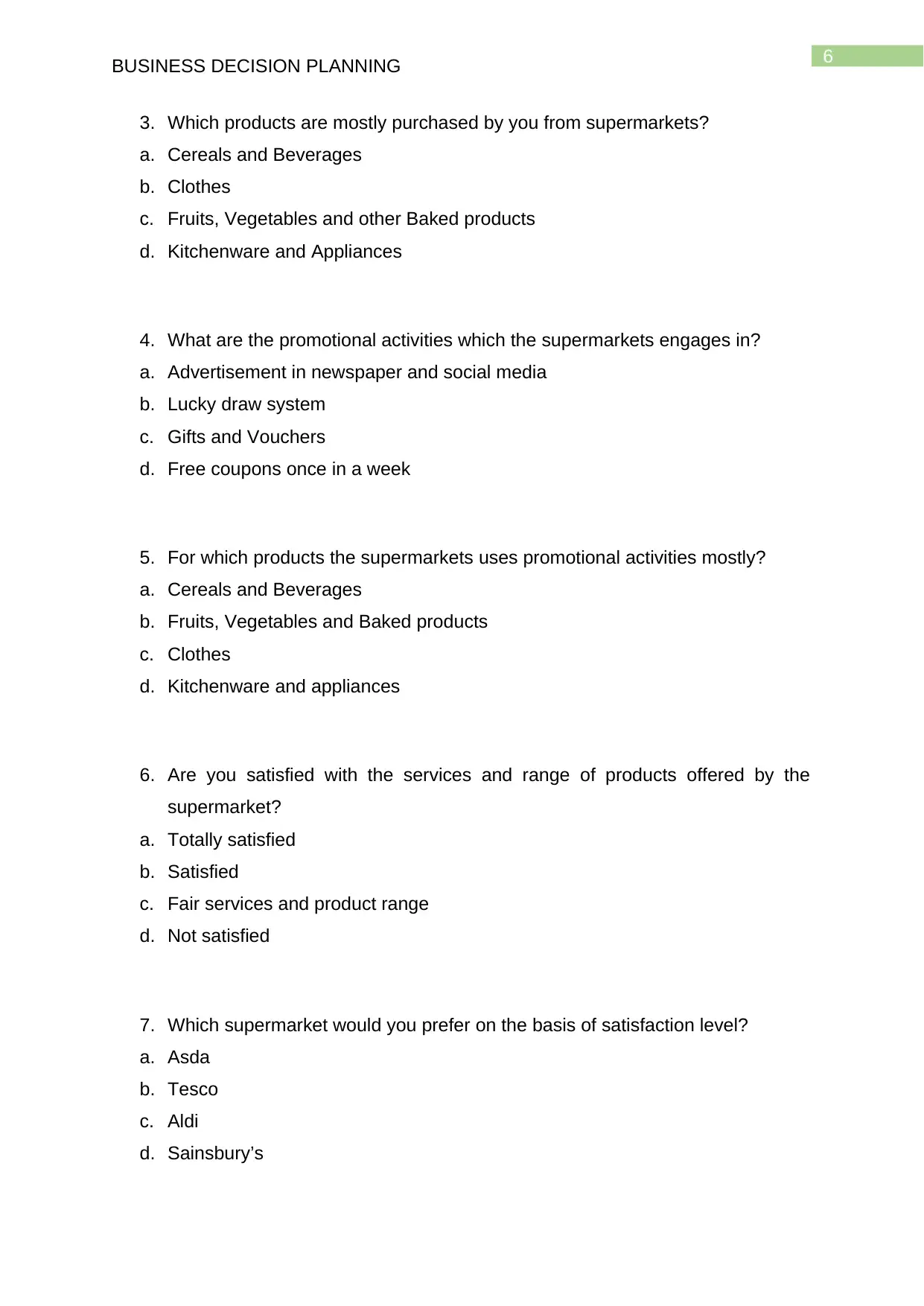
6
BUSINESS DECISION PLANNING
3. Which products are mostly purchased by you from supermarkets?
a. Cereals and Beverages
b. Clothes
c. Fruits, Vegetables and other Baked products
d. Kitchenware and Appliances
4. What are the promotional activities which the supermarkets engages in?
a. Advertisement in newspaper and social media
b. Lucky draw system
c. Gifts and Vouchers
d. Free coupons once in a week
5. For which products the supermarkets uses promotional activities mostly?
a. Cereals and Beverages
b. Fruits, Vegetables and Baked products
c. Clothes
d. Kitchenware and appliances
6. Are you satisfied with the services and range of products offered by the
supermarket?
a. Totally satisfied
b. Satisfied
c. Fair services and product range
d. Not satisfied
7. Which supermarket would you prefer on the basis of satisfaction level?
a. Asda
b. Tesco
c. Aldi
d. Sainsbury’s
BUSINESS DECISION PLANNING
3. Which products are mostly purchased by you from supermarkets?
a. Cereals and Beverages
b. Clothes
c. Fruits, Vegetables and other Baked products
d. Kitchenware and Appliances
4. What are the promotional activities which the supermarkets engages in?
a. Advertisement in newspaper and social media
b. Lucky draw system
c. Gifts and Vouchers
d. Free coupons once in a week
5. For which products the supermarkets uses promotional activities mostly?
a. Cereals and Beverages
b. Fruits, Vegetables and Baked products
c. Clothes
d. Kitchenware and appliances
6. Are you satisfied with the services and range of products offered by the
supermarket?
a. Totally satisfied
b. Satisfied
c. Fair services and product range
d. Not satisfied
7. Which supermarket would you prefer on the basis of satisfaction level?
a. Asda
b. Tesco
c. Aldi
d. Sainsbury’s
Paraphrase This Document
Need a fresh take? Get an instant paraphrase of this document with our AI Paraphraser
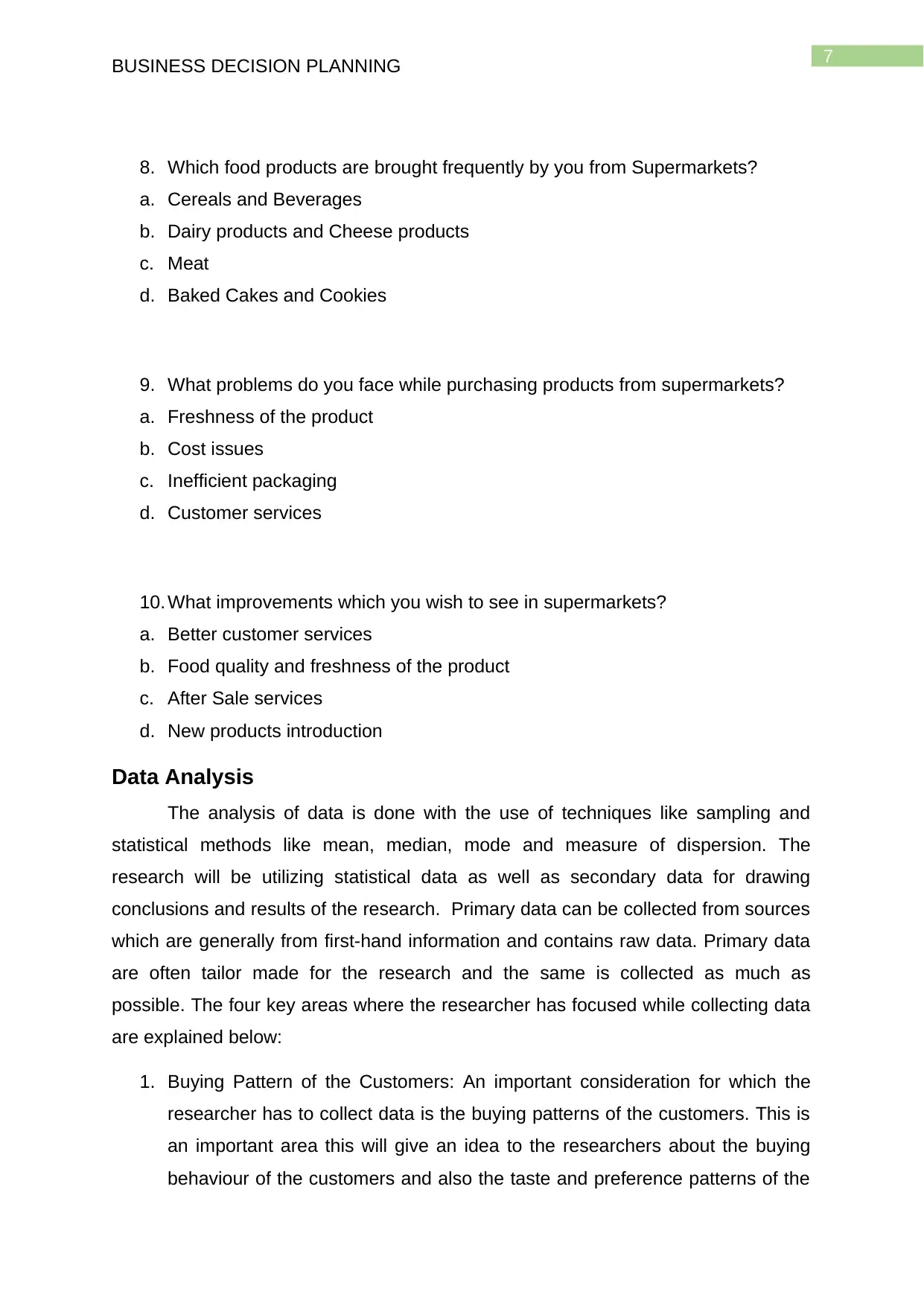
7
BUSINESS DECISION PLANNING
8. Which food products are brought frequently by you from Supermarkets?
a. Cereals and Beverages
b. Dairy products and Cheese products
c. Meat
d. Baked Cakes and Cookies
9. What problems do you face while purchasing products from supermarkets?
a. Freshness of the product
b. Cost issues
c. Inefficient packaging
d. Customer services
10. What improvements which you wish to see in supermarkets?
a. Better customer services
b. Food quality and freshness of the product
c. After Sale services
d. New products introduction
Data Analysis
The analysis of data is done with the use of techniques like sampling and
statistical methods like mean, median, mode and measure of dispersion. The
research will be utilizing statistical data as well as secondary data for drawing
conclusions and results of the research. Primary data can be collected from sources
which are generally from first-hand information and contains raw data. Primary data
are often tailor made for the research and the same is collected as much as
possible. The four key areas where the researcher has focused while collecting data
are explained below:
1. Buying Pattern of the Customers: An important consideration for which the
researcher has to collect data is the buying patterns of the customers. This is
an important area this will give an idea to the researchers about the buying
behaviour of the customers and also the taste and preference patterns of the
BUSINESS DECISION PLANNING
8. Which food products are brought frequently by you from Supermarkets?
a. Cereals and Beverages
b. Dairy products and Cheese products
c. Meat
d. Baked Cakes and Cookies
9. What problems do you face while purchasing products from supermarkets?
a. Freshness of the product
b. Cost issues
c. Inefficient packaging
d. Customer services
10. What improvements which you wish to see in supermarkets?
a. Better customer services
b. Food quality and freshness of the product
c. After Sale services
d. New products introduction
Data Analysis
The analysis of data is done with the use of techniques like sampling and
statistical methods like mean, median, mode and measure of dispersion. The
research will be utilizing statistical data as well as secondary data for drawing
conclusions and results of the research. Primary data can be collected from sources
which are generally from first-hand information and contains raw data. Primary data
are often tailor made for the research and the same is collected as much as
possible. The four key areas where the researcher has focused while collecting data
are explained below:
1. Buying Pattern of the Customers: An important consideration for which the
researcher has to collect data is the buying patterns of the customers. This is
an important area this will give an idea to the researchers about the buying
behaviour of the customers and also the taste and preference patterns of the
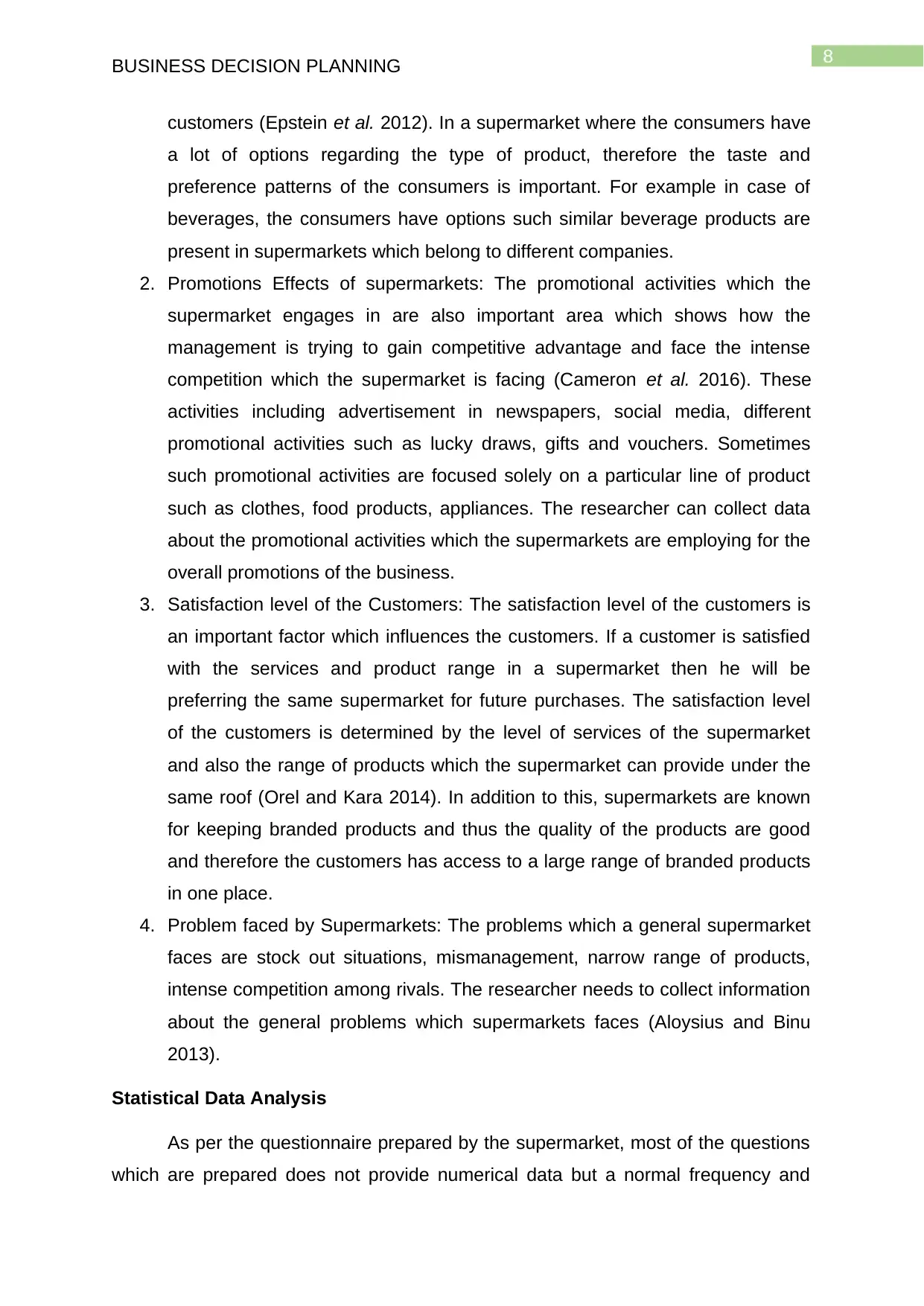
8
BUSINESS DECISION PLANNING
customers (Epstein et al. 2012). In a supermarket where the consumers have
a lot of options regarding the type of product, therefore the taste and
preference patterns of the consumers is important. For example in case of
beverages, the consumers have options such similar beverage products are
present in supermarkets which belong to different companies.
2. Promotions Effects of supermarkets: The promotional activities which the
supermarket engages in are also important area which shows how the
management is trying to gain competitive advantage and face the intense
competition which the supermarket is facing (Cameron et al. 2016). These
activities including advertisement in newspapers, social media, different
promotional activities such as lucky draws, gifts and vouchers. Sometimes
such promotional activities are focused solely on a particular line of product
such as clothes, food products, appliances. The researcher can collect data
about the promotional activities which the supermarkets are employing for the
overall promotions of the business.
3. Satisfaction level of the Customers: The satisfaction level of the customers is
an important factor which influences the customers. If a customer is satisfied
with the services and product range in a supermarket then he will be
preferring the same supermarket for future purchases. The satisfaction level
of the customers is determined by the level of services of the supermarket
and also the range of products which the supermarket can provide under the
same roof (Orel and Kara 2014). In addition to this, supermarkets are known
for keeping branded products and thus the quality of the products are good
and therefore the customers has access to a large range of branded products
in one place.
4. Problem faced by Supermarkets: The problems which a general supermarket
faces are stock out situations, mismanagement, narrow range of products,
intense competition among rivals. The researcher needs to collect information
about the general problems which supermarkets faces (Aloysius and Binu
2013).
Statistical Data Analysis
As per the questionnaire prepared by the supermarket, most of the questions
which are prepared does not provide numerical data but a normal frequency and
BUSINESS DECISION PLANNING
customers (Epstein et al. 2012). In a supermarket where the consumers have
a lot of options regarding the type of product, therefore the taste and
preference patterns of the consumers is important. For example in case of
beverages, the consumers have options such similar beverage products are
present in supermarkets which belong to different companies.
2. Promotions Effects of supermarkets: The promotional activities which the
supermarket engages in are also important area which shows how the
management is trying to gain competitive advantage and face the intense
competition which the supermarket is facing (Cameron et al. 2016). These
activities including advertisement in newspapers, social media, different
promotional activities such as lucky draws, gifts and vouchers. Sometimes
such promotional activities are focused solely on a particular line of product
such as clothes, food products, appliances. The researcher can collect data
about the promotional activities which the supermarkets are employing for the
overall promotions of the business.
3. Satisfaction level of the Customers: The satisfaction level of the customers is
an important factor which influences the customers. If a customer is satisfied
with the services and product range in a supermarket then he will be
preferring the same supermarket for future purchases. The satisfaction level
of the customers is determined by the level of services of the supermarket
and also the range of products which the supermarket can provide under the
same roof (Orel and Kara 2014). In addition to this, supermarkets are known
for keeping branded products and thus the quality of the products are good
and therefore the customers has access to a large range of branded products
in one place.
4. Problem faced by Supermarkets: The problems which a general supermarket
faces are stock out situations, mismanagement, narrow range of products,
intense competition among rivals. The researcher needs to collect information
about the general problems which supermarkets faces (Aloysius and Binu
2013).
Statistical Data Analysis
As per the questionnaire prepared by the supermarket, most of the questions
which are prepared does not provide numerical data but a normal frequency and
⊘ This is a preview!⊘
Do you want full access?
Subscribe today to unlock all pages.

Trusted by 1+ million students worldwide
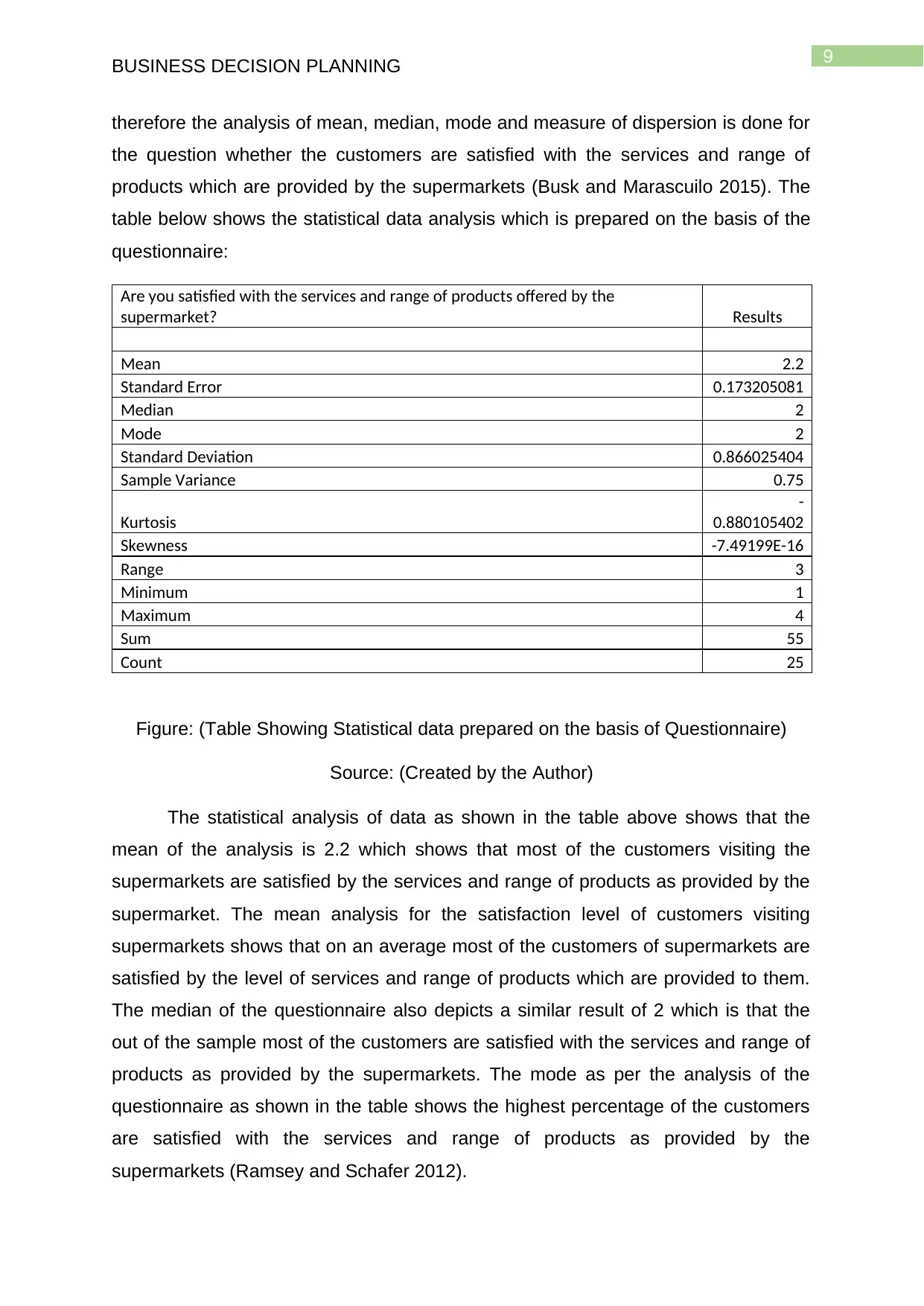
9
BUSINESS DECISION PLANNING
therefore the analysis of mean, median, mode and measure of dispersion is done for
the question whether the customers are satisfied with the services and range of
products which are provided by the supermarkets (Busk and Marascuilo 2015). The
table below shows the statistical data analysis which is prepared on the basis of the
questionnaire:
Are you satisfied with the services and range of products offered by the
supermarket? Results
Mean 2.2
Standard Error 0.173205081
Median 2
Mode 2
Standard Deviation 0.866025404
Sample Variance 0.75
Kurtosis
-
0.880105402
Skewness -7.49199E-16
Range 3
Minimum 1
Maximum 4
Sum 55
Count 25
Figure: (Table Showing Statistical data prepared on the basis of Questionnaire)
Source: (Created by the Author)
The statistical analysis of data as shown in the table above shows that the
mean of the analysis is 2.2 which shows that most of the customers visiting the
supermarkets are satisfied by the services and range of products as provided by the
supermarket. The mean analysis for the satisfaction level of customers visiting
supermarkets shows that on an average most of the customers of supermarkets are
satisfied by the level of services and range of products which are provided to them.
The median of the questionnaire also depicts a similar result of 2 which is that the
out of the sample most of the customers are satisfied with the services and range of
products as provided by the supermarkets. The mode as per the analysis of the
questionnaire as shown in the table shows the highest percentage of the customers
are satisfied with the services and range of products as provided by the
supermarkets (Ramsey and Schafer 2012).
BUSINESS DECISION PLANNING
therefore the analysis of mean, median, mode and measure of dispersion is done for
the question whether the customers are satisfied with the services and range of
products which are provided by the supermarkets (Busk and Marascuilo 2015). The
table below shows the statistical data analysis which is prepared on the basis of the
questionnaire:
Are you satisfied with the services and range of products offered by the
supermarket? Results
Mean 2.2
Standard Error 0.173205081
Median 2
Mode 2
Standard Deviation 0.866025404
Sample Variance 0.75
Kurtosis
-
0.880105402
Skewness -7.49199E-16
Range 3
Minimum 1
Maximum 4
Sum 55
Count 25
Figure: (Table Showing Statistical data prepared on the basis of Questionnaire)
Source: (Created by the Author)
The statistical analysis of data as shown in the table above shows that the
mean of the analysis is 2.2 which shows that most of the customers visiting the
supermarkets are satisfied by the services and range of products as provided by the
supermarket. The mean analysis for the satisfaction level of customers visiting
supermarkets shows that on an average most of the customers of supermarkets are
satisfied by the level of services and range of products which are provided to them.
The median of the questionnaire also depicts a similar result of 2 which is that the
out of the sample most of the customers are satisfied with the services and range of
products as provided by the supermarkets. The mode as per the analysis of the
questionnaire as shown in the table shows the highest percentage of the customers
are satisfied with the services and range of products as provided by the
supermarkets (Ramsey and Schafer 2012).
Paraphrase This Document
Need a fresh take? Get an instant paraphrase of this document with our AI Paraphraser
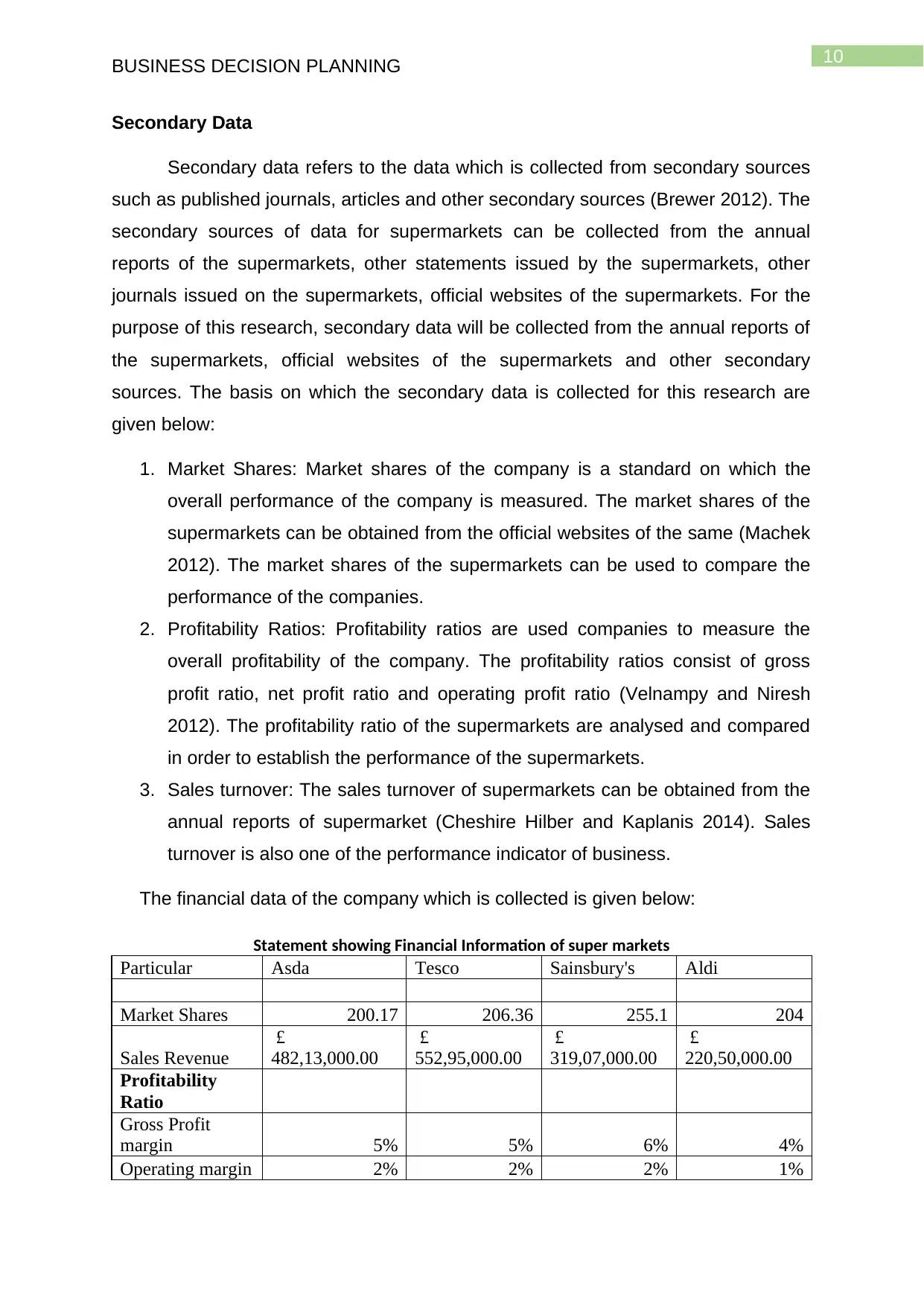
10
BUSINESS DECISION PLANNING
Secondary Data
Secondary data refers to the data which is collected from secondary sources
such as published journals, articles and other secondary sources (Brewer 2012). The
secondary sources of data for supermarkets can be collected from the annual
reports of the supermarkets, other statements issued by the supermarkets, other
journals issued on the supermarkets, official websites of the supermarkets. For the
purpose of this research, secondary data will be collected from the annual reports of
the supermarkets, official websites of the supermarkets and other secondary
sources. The basis on which the secondary data is collected for this research are
given below:
1. Market Shares: Market shares of the company is a standard on which the
overall performance of the company is measured. The market shares of the
supermarkets can be obtained from the official websites of the same (Machek
2012). The market shares of the supermarkets can be used to compare the
performance of the companies.
2. Profitability Ratios: Profitability ratios are used companies to measure the
overall profitability of the company. The profitability ratios consist of gross
profit ratio, net profit ratio and operating profit ratio (Velnampy and Niresh
2012). The profitability ratio of the supermarkets are analysed and compared
in order to establish the performance of the supermarkets.
3. Sales turnover: The sales turnover of supermarkets can be obtained from the
annual reports of supermarket (Cheshire Hilber and Kaplanis 2014). Sales
turnover is also one of the performance indicator of business.
The financial data of the company which is collected is given below:
Statement showing Financial Information of super markets
Particular Asda Tesco Sainsbury's Aldi
Market Shares 200.17 206.36 255.1 204
Sales Revenue
£
482,13,000.00
£
552,95,000.00
£
319,07,000.00
£
220,50,000.00
Profitability
Ratio
Gross Profit
margin 5% 5% 6% 4%
Operating margin 2% 2% 2% 1%
BUSINESS DECISION PLANNING
Secondary Data
Secondary data refers to the data which is collected from secondary sources
such as published journals, articles and other secondary sources (Brewer 2012). The
secondary sources of data for supermarkets can be collected from the annual
reports of the supermarkets, other statements issued by the supermarkets, other
journals issued on the supermarkets, official websites of the supermarkets. For the
purpose of this research, secondary data will be collected from the annual reports of
the supermarkets, official websites of the supermarkets and other secondary
sources. The basis on which the secondary data is collected for this research are
given below:
1. Market Shares: Market shares of the company is a standard on which the
overall performance of the company is measured. The market shares of the
supermarkets can be obtained from the official websites of the same (Machek
2012). The market shares of the supermarkets can be used to compare the
performance of the companies.
2. Profitability Ratios: Profitability ratios are used companies to measure the
overall profitability of the company. The profitability ratios consist of gross
profit ratio, net profit ratio and operating profit ratio (Velnampy and Niresh
2012). The profitability ratio of the supermarkets are analysed and compared
in order to establish the performance of the supermarkets.
3. Sales turnover: The sales turnover of supermarkets can be obtained from the
annual reports of supermarket (Cheshire Hilber and Kaplanis 2014). Sales
turnover is also one of the performance indicator of business.
The financial data of the company which is collected is given below:
Statement showing Financial Information of super markets
Particular Asda Tesco Sainsbury's Aldi
Market Shares 200.17 206.36 255.1 204
Sales Revenue
£
482,13,000.00
£
552,95,000.00
£
319,07,000.00
£
220,50,000.00
Profitability
Ratio
Gross Profit
margin 5% 5% 6% 4%
Operating margin 2% 2% 2% 1%
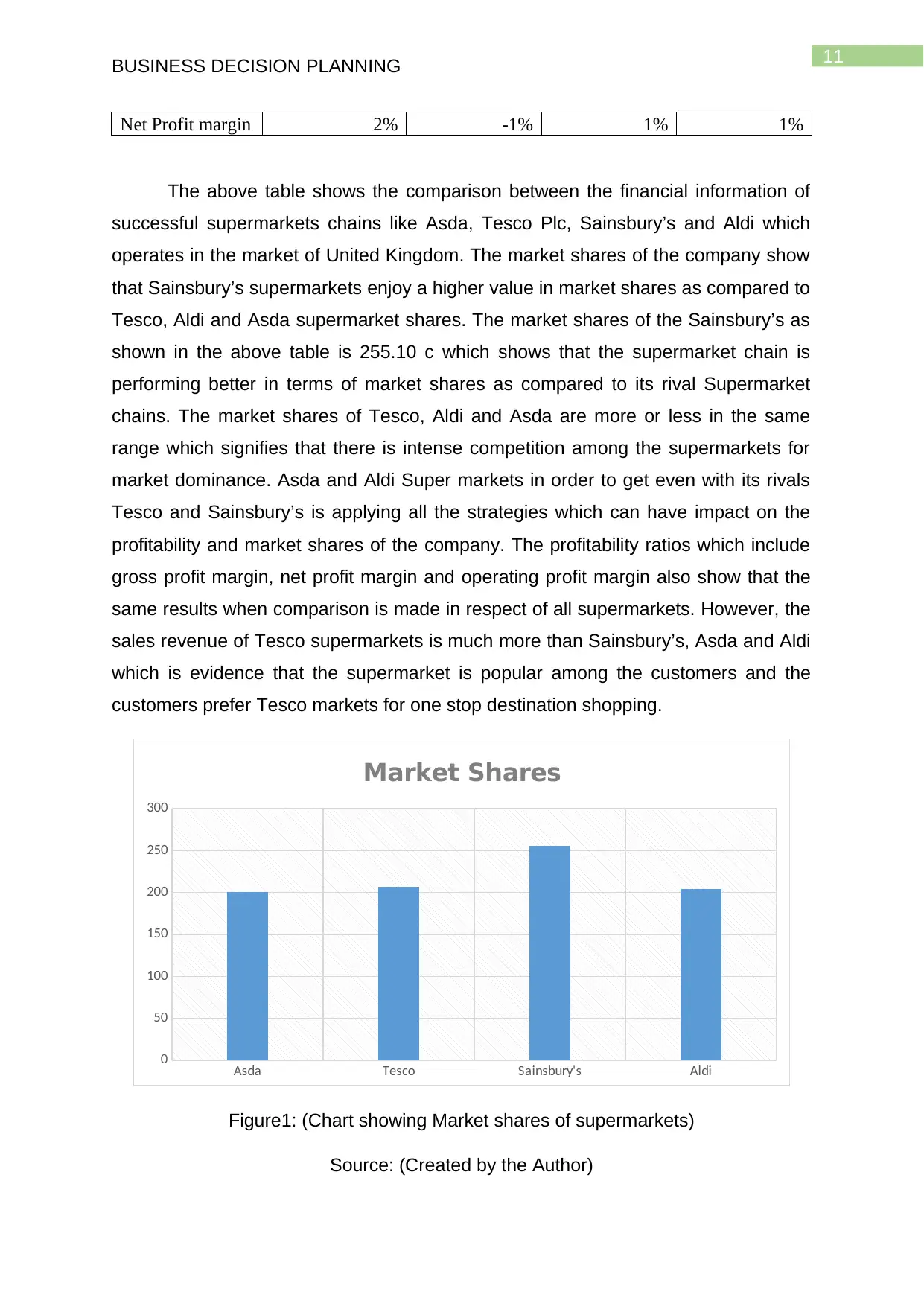
11
BUSINESS DECISION PLANNING
Net Profit margin 2% -1% 1% 1%
The above table shows the comparison between the financial information of
successful supermarkets chains like Asda, Tesco Plc, Sainsbury’s and Aldi which
operates in the market of United Kingdom. The market shares of the company show
that Sainsbury’s supermarkets enjoy a higher value in market shares as compared to
Tesco, Aldi and Asda supermarket shares. The market shares of the Sainsbury’s as
shown in the above table is 255.10 c which shows that the supermarket chain is
performing better in terms of market shares as compared to its rival Supermarket
chains. The market shares of Tesco, Aldi and Asda are more or less in the same
range which signifies that there is intense competition among the supermarkets for
market dominance. Asda and Aldi Super markets in order to get even with its rivals
Tesco and Sainsbury’s is applying all the strategies which can have impact on the
profitability and market shares of the company. The profitability ratios which include
gross profit margin, net profit margin and operating profit margin also show that the
same results when comparison is made in respect of all supermarkets. However, the
sales revenue of Tesco supermarkets is much more than Sainsbury’s, Asda and Aldi
which is evidence that the supermarket is popular among the customers and the
customers prefer Tesco markets for one stop destination shopping.
Asda Tesco Sainsbury's Aldi
0
50
100
150
200
250
300
Market Shares
Figure1: (Chart showing Market shares of supermarkets)
Source: (Created by the Author)
BUSINESS DECISION PLANNING
Net Profit margin 2% -1% 1% 1%
The above table shows the comparison between the financial information of
successful supermarkets chains like Asda, Tesco Plc, Sainsbury’s and Aldi which
operates in the market of United Kingdom. The market shares of the company show
that Sainsbury’s supermarkets enjoy a higher value in market shares as compared to
Tesco, Aldi and Asda supermarket shares. The market shares of the Sainsbury’s as
shown in the above table is 255.10 c which shows that the supermarket chain is
performing better in terms of market shares as compared to its rival Supermarket
chains. The market shares of Tesco, Aldi and Asda are more or less in the same
range which signifies that there is intense competition among the supermarkets for
market dominance. Asda and Aldi Super markets in order to get even with its rivals
Tesco and Sainsbury’s is applying all the strategies which can have impact on the
profitability and market shares of the company. The profitability ratios which include
gross profit margin, net profit margin and operating profit margin also show that the
same results when comparison is made in respect of all supermarkets. However, the
sales revenue of Tesco supermarkets is much more than Sainsbury’s, Asda and Aldi
which is evidence that the supermarket is popular among the customers and the
customers prefer Tesco markets for one stop destination shopping.
Asda Tesco Sainsbury's Aldi
0
50
100
150
200
250
300
Market Shares
Figure1: (Chart showing Market shares of supermarkets)
Source: (Created by the Author)
⊘ This is a preview!⊘
Do you want full access?
Subscribe today to unlock all pages.

Trusted by 1+ million students worldwide
1 out of 24
Related Documents
Your All-in-One AI-Powered Toolkit for Academic Success.
+13062052269
info@desklib.com
Available 24*7 on WhatsApp / Email
![[object Object]](/_next/static/media/star-bottom.7253800d.svg)
Unlock your academic potential
Copyright © 2020–2025 A2Z Services. All Rights Reserved. Developed and managed by ZUCOL.




